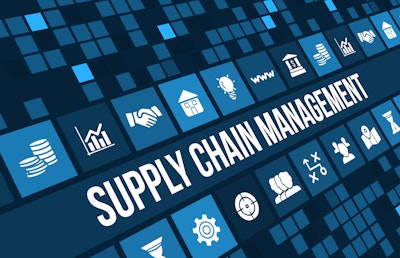
In today’s interconnected and fast-paced world, supply chains face unprecedented challenges. From global interdependencies to the increasing complexity of operations, disruptions such as demand fluctuations and logistics delays have become the norm. According to a recent study, almost 80% of organizations’ supply chains were disrupted over the last 12 months, underscoring the urgency for innovative solutions.
Amid these challenges, a transformative approach known as orchestration intelligence is emerging as the next evolution in supply chain management. By leveraging advanced data integration, real-time visibility, and artificial intelligence (AI), orchestration intelligence enables businesses to make smarter, faster decisions, ensuring seamless operations in this rapidly changing landscape.
What is orchestration intelligence?
At its core, orchestration intelligence builds upon the principles of supply chain orchestration, integrating the people, processes, and data across the supply chain to achieve intelligent, end-to-end management. This framework coordinates everything from procurement and manufacturing to distribution and logistics to ensure cost-effective, secure, and efficient delivery of products.
Orchestration intelligence goes beyond traditional automation by providing a platform that connects the entire supply chain, ensuring end-to-end visibility and illuminating blind spots. By leveraging real-time data and predictive analytics it enables dynamic decision-making, continuously updating recommendations, and optimizing processes. For instance, if a production delay occurs, orchestration intelligence helps identify alternative solutions, such as redirecting inventory or adjusting schedules to minimize downstream effects in the supply chain.
Orchestration intelligence vs. traditional automation
Traditional automation focuses on digitizing and automating the workflows of specific tasks or processes to improve efficiency. While this can drive localized outcomes, it often operates in silos, limiting broader impact. Orchestration builds on the output of automation, extending beyond individual operations, linking upstream and downstream supply chain partners to integrate the business processes, data, and workflows to create a synchronized, end-to-end network.
Intelligence adds the decision-making element. The integration of real-time data and AI is pivotal to this shift. Unlike traditional systems, orchestration intelligence enables the ability to dynamically adapt to changing conditions, allowing businesses to respond proactively rather than reactively. For example, machine learning algorithms can forecast demand fluctuations, enabling precise inventory adjustments and reducing both overstock and stockouts, and maximizing revenue.
Driving operational improvements and strategic impacts
The ability to dynamically adapt to changing conditions isn’t limited to inventory management. Orchestration intelligence revolutionizes how the supply chain can operate, enabling a company and all of its network partners to collaborate and interoperate across the spectrum of shared business processes from supply and demand planning to order-to-cash operations and more. This interconnected approach, based on a foundation of accurate, real-time data mobilized between business systems and at the fingertips of key stakeholders across these processes, strengthens relationships and lays the foundation for a resilient and efficient supply network.
The benefits are varied on an operational level, helping ensure key areas like supply chain resilience. For example, digitalizing forecast plans with suppliers can increase predictability, ensuring timely deliveries and minimizing disruptions. If disruptions like logistics delays do occur, orchestration intelligence provides real-time visibility and actionable insights that allow stakeholders to identify alternative solutions and take action swiftly.
More importantly, orchestration intelligence can be a strategic driver, allowing the supply chain leader to clearly and tangibly impact key strategic imperatives for the business. For example, maximizing revenue by avoiding out-of-stocks and facilitating new commercial channels, freeing up working capital by optimizing inventory and improving supply/demand planning, and improving operational efficiency and business productivity through digitalization and business process automation.
Enabling orchestration intelligence with legacy systems and your network
A fundamental requirement for orchestration intelligence is that all parties in a company’s supply chain need to be able to participate, not just the few large players. Realizing the true strategic potential of an orchestration intelligence platform mandates digitally linking with every supply chain partner. Some companies may then hesitate to adopt these capabilities due to traditional concerns about launching massive IT projects or disrupting existing systems.
An orchestration intelligence platform addresses these concerns head-on by enabling a true integrate-once, interoperate-with-everyone link between your company and your enterprise systems with all of your supply chain partners. This enables digitalization of all supply chain processes, without having to change or significantly upgrade your legacy enterprise systems, and without forcing your network partners to change their systems. As a result, it allows all partners in your network to participate and digitally exchange information, regardless of their systems or technical sophistication.
Companies can then focus time and resources on more important areas, such as identifying the business operations with the greatest need or strategic impact to get started with.
Key areas to help drive this enablement include:
● Value roadmapping: Assess current operations, define digitalization objectives, and prioritize initiatives based on value and feasibility.
● Incremental implementation: Start with high-impact processes and gradually expand integration.
● Stakeholder communication: Clearly articulate the benefits and ROI to gain buy-in from all parties.
Avoiding common pitfalls, such as inadequate training or poor data integration, will help ensure a smoother transition and maximize the impact of orchestration intelligence in your environment.
Powering tomorrow’s supply chain transformation today
Orchestration intelligence represents a transformative leap for supply chains. It unites people, processes, and data, it delivers unprecedented levels of visibility, collaboration, and decision-making power, and it feeds the next generation of AI potential to leverage AI for action that is so critical for today’s business. By having a digitalized integrated supply chain network, you can finally turn your supply chain into a strategic enabler for your business. As global supply chains grow more complex, now is the time to invest in orchestration intelligence, paving the way for a smarter, more connected supply chain network.



















